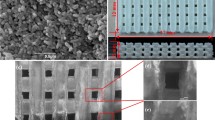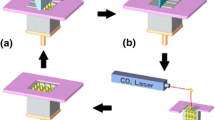Abstract
This study forms hydroxyapatite-silica ceramic structure, which can generate interconnected porous 3D models suitable as bone scaffold, using a novel selective laser sintering (SLS) technique. Hydroxyapatite (HA) powder and a silica sol are first mixed into slurries. After processing by SLS, the HA particles are embedded in the gelled silica matrix to form green parts. The processed parts are analyzed by scanning electron microscopy (SEM). The number of cells attached on this scaffold surface is obtained by the in vitro cultured cells test. The higher number of viable cells are obtained when the sintering temperature of the scaffold was 1200°C at day 4 of cell culturing. The proposed technology can be applied to generate a bone scaffold model of porous bio-ceramics for biomedicine.
Similar content being viewed by others
References
Xiao, K., Dalgarno, K. W., Wood, D. J., Goodridge, R. D. and Ohtsuki, C., “Indirect selective laser sintering of apatite-wollost onite glass-ceramic,” Proceedings of the Institution of Mechanical Engineers Part H: Journal of engineering in medicine, Vol. 222, No. 7, pp. 1107–1114, 2008.
Babini, G. N., Bellosi, A. and Vincenzini, P., “Oxidation of silicon nitride hot pressed with Y2O3+MgO,” J. Mater. Sci., Vol. 18, No. 1, pp. 231–244, 1983.
Cyster, L. A., Grant, D. M., Howdle, S. M., Rose, F. R. A. J., Irvine, D. J., Freeman, D. and Shakesheff, K. M., “The influence of dispersant concentration on the pore morphology of hydroxyapatite ceramics for bone tissue engineering,” Biomaterials, Vol. 26, No. 7, pp. 697–702, 2005.
Almirall, A., Larrecq, G., Delgado, J. A., Martínez, S., Planell, J. A. and Ginebra, M. P., “Fabrication of low temperature macroporous hydroxyapatite scaffolds by foaming and hydrolysis of an α-TCP paste,” Biomaterials, Vol. 25, No. 17, pp. 3671–3680, 2004.
Lorrison, J. C., Dalgarno, K. W. and Wood, D. J., “Processing of an apatite-mullite glass-ceramic and an hydroxyapatite/phosphate glass composite by selective laser sintering,” J. Mater. Sci. Mater. Med., Vol. 16, No. 8, pp. 775–781, 2005.
Yang, S. F., Leong, K. F., Du, Z. H. and Chua, C. K., “The design of scaffolds for use in tissue engineering. Part Ι. Traditional factors,” Tissue Eng., Vol. 7, No. 6, pp. 679–689, 2001.
Ho, M. H., Kuo, P. Y., Hsieh, H. J., Hsien, T. Y., Hou, L. T., Lai, J. Y. and Wang, D. M., “Preparation of porous scaffolds by using freeze-extraction and freeze-gelation methods,” Biomaterials, Vol. 25, No. 1, pp. 129–138, 2004.
Chen, V. J. and Ma, P. X., “Nano-fibrous poly (L-lactic acid) scaffolds with interconnected spherical macropores,” Biomaterials, Vol. 25, No. 11, pp. 2065–2073, 2004.
Chua, C. K. and Leong, K. F., “Rapid Prototyping: Principles and Applications in Manufacturing,” John Wiley & Sons, 1997.
Liu, F. H. and Liao, Y. S., “Fabrication of inner complex ceramic parts by selective laser gelling,” J. Eur. Ceram. Soc., Vol. 30, No. 16, pp. 3283–3289, 2010.
Liu, F. H., “Manufacturing porous multi-channel ceramics by laser gelling,” Ceram. Int., Vol. 37, No. 7, pp. 2789–2794, 2011.
Williams, J., Miller, D. and Deckard, C., “Selective laser sintering part strength as a function of Andrew number, scan rate and spot size,” Proc. of the Solid Freeform Fabrication Symposium, pp. 549–557, 1996.
Liu, F. H., Shen, Y. K. and Liao, Y. S., “Selective laser gelation of ceramic-matrix composites,” Compos. Part B: Engineering, Vol. 42, No. 1, pp. 57–61, 2011.
Gauthier, M. J., Bouler, E., Arguado, E., Pilet, P. and Daculsi, G., “Macroporous biphasic calcium phosphate ceramic: influence of macropore diameter and macroporosity percentage on bone ingrowth,” Biomaterials, Vol. 19, No. 1–3, pp. 133–139, 1998.
Park, S., Kim, G. H., Jeon, Y. C., Koh, Y. H. and Kim, W. D., “3D polycaprolactone scaffolds with controlled pore structure using a rapid prototyping system,” J. Mater. Sci. Mater. Med., Vol. 20, No. 1, pp. 229–234, 2009.
Author information
Authors and Affiliations
Corresponding author
Rights and permissions
About this article
Cite this article
Liu, FH., Shen, YK. & Lee, JL. Selective laser sintering of a hydroxyapatite-silica scaffold on cultured MG63 osteoblasts in vitro. Int. J. Precis. Eng. Manuf. 13, 439–444 (2012). https://doi.org/10.1007/s12541-012-0056-9
Received:
Accepted:
Published:
Issue Date:
DOI: https://doi.org/10.1007/s12541-012-0056-9




